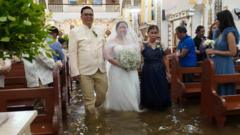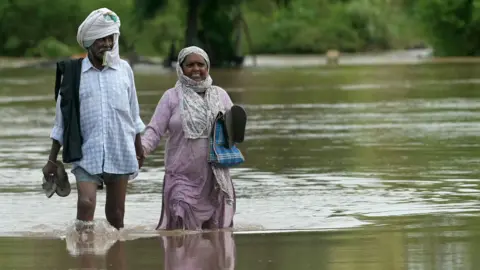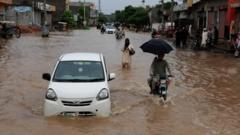One recent wedding saw bride Jamaica Aguilar and groom Jade Rick Verdillo walk down a knee-deep flooded aisle, turning their significant day into a viral testament to Filipino resilience. Despite warnings from planners about worsening weather, the couple chose to prioritize their love and the presence of family over challenging conditions. For them, the emotional significance outweighed the hurdles presented by the flooding, which was unfortunately not a new occurrence.
This situation has recurred over the years, with similar stories emerging from the very same church and surrounding areas, reflecting a sad pattern of flooding that has deeply affected local communities. The Philippine archipelago, located in a region prone to tropical cyclones, sees about 20 storms a year, many of which result in devastating floods. As expressed by the newlyweds, the ceremonial challenges were only a microcosm of the struggles faced daily by millions in the region.
The response to this flooding crisis has involved discussions of infrastructure failure and an urgent need for urban planning reform. With a dilapidated sewage system dating back to the early 1900s and waste management poorly handled in Metro Manila, environmental experts point to a failing ecosystem exacerbated by climate change. Recent comments from public works minister Manuel Bonoan suggest an immediate push for repairs on water pumping stations and canal expansion, funded partially by the World Bank.
As storms become increasingly frequent and aggressive, the looming question remains: Will systemic issues in urban management be addressed sufficiently to eliminate the risk of bridal parties wading through water? The hope shared by many, including newlywed Verdillo, lies in sustainable investments and strategic planning aimed at mitigating flooding, aiming for brighter, drier futures for both lovers and the greater community alike.
This situation has recurred over the years, with similar stories emerging from the very same church and surrounding areas, reflecting a sad pattern of flooding that has deeply affected local communities. The Philippine archipelago, located in a region prone to tropical cyclones, sees about 20 storms a year, many of which result in devastating floods. As expressed by the newlyweds, the ceremonial challenges were only a microcosm of the struggles faced daily by millions in the region.
The response to this flooding crisis has involved discussions of infrastructure failure and an urgent need for urban planning reform. With a dilapidated sewage system dating back to the early 1900s and waste management poorly handled in Metro Manila, environmental experts point to a failing ecosystem exacerbated by climate change. Recent comments from public works minister Manuel Bonoan suggest an immediate push for repairs on water pumping stations and canal expansion, funded partially by the World Bank.
As storms become increasingly frequent and aggressive, the looming question remains: Will systemic issues in urban management be addressed sufficiently to eliminate the risk of bridal parties wading through water? The hope shared by many, including newlywed Verdillo, lies in sustainable investments and strategic planning aimed at mitigating flooding, aiming for brighter, drier futures for both lovers and the greater community alike.



















